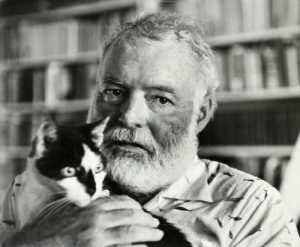Ernest Hemingway is one of the most significant writers of the 20th century, whose prose combines conciseness, realism, and deep philosophical reflections on life and death. His works depict harsh realities, human suffering, and the search for meaning in a world often governed by chance and uncertainty. Hemingway’s realism manifests not only in the accuracy of his descriptions of the surrounding world but also in the psychological authenticity of his characters. Existential motifs are seamlessly interwoven with the lives of ordinary people, showing how loneliness, meaninglessness, and moral dilemmas shape their destinies.
Hemingway skillfully uses short, minimalist sentences to convey the inner states of his characters, as well as the tension and drama of events. At the center of his works is a human being confronted with challenges, facing inevitable death or internal emptiness. The author does not offer ready-made solutions or impose moral lessons; he merely presents reality, leaving the reader to interpret the events.
 Realism in Hemingway’s Prose: Precision and Restraint
Realism in Hemingway’s Prose: Precision and Restraint
Hemingway’s realism appears in details that may seem simple or mundane at first glance, but which create a strong sense of authenticity. The author carefully describes the physical environment, daily conditions, and the behavior of people and animals, emphasizing that human life is constantly connected to struggle and limitations.
An example is the novel The Old Man and the Sea. The fisherman Santiago lives in a real fishing environment, facing physical challenges, fatigue, and solitude. The descriptions of the sea, the movements of the fish, and Santiago’s efforts to battle nature demonstrate not romantic embellishment but the strict truth of life. At the same time, through these real events, the author conveys the emotional and philosophical experiences of the character.
Another example is A Farewell to Arms, where the life on the front and the love between Frederic and Catherine are portrayed through the lens of everyday reality and the violence of war. Hemingway avoids excessive pathos and dramatic devices typical of romantic tradition. The reader experiences the cold truth of war: fear, death, injury, alienation, and moral ambiguity.
A key feature of Hemingway’s realism is that details of the external world serve not only to illustrate but also to reveal the character’s inner state. Simple objects, everyday actions, and conversations create a rich psychological palette. This method was called the “Iceberg Theory”, where the majority of the content lies beneath the surface, and the reader senses meaning intuitively.
Hemingway’s realism also manifests in the emotional tone of his narratives. He avoids verbosity and unnecessary description, focusing on specific details: the smell of the sea, the weight of the fish, the fatigue of the old man, the way a person observes the world. This approach heightens the sense of truthfulness and allows the reader to feel like a witness rather than a passive consumer of fiction.
Existential Themes: Meaninglessness and Loneliness
Existential motifs occupy a central place in Hemingway’s work. His characters often confront the meaninglessness of events, isolation, and the necessity of making decisions without external guidance. The sense of emptiness and the limitations of human life form the philosophical core of his texts.
In The Old Man and the Sea, Santiago’s solitude symbolizes the inner struggle of a person with himself and nature. The old man must rely solely on his own strength, reflect on the meaning of life, and endure suffering with resilience. The fish as an opponent becomes a metaphor for difficulties that cannot be fully controlled, while also representing personal value and purpose.
In the short story Hills Like White Elephants, Hemingway presents an existential choice in an ordinary situation: a conversation between a couple about abortion turns into a meditation on freedom, responsibility, and the constraints of human life. Every action and dialogue underscores the need for independent decision-making in a world where moral guidelines are blurred.
Existential themes are also expressed through the awareness of death and loss. War in A Farewell to Arms serves as a backdrop for understanding the transience of life, its unpredictability, and moral ambiguity. Characters perceive the futility of suffering and the necessity of choice even amid chaos.
Additionally, Hemingway frequently presents the phenomenon of the “hero without illusions”—a character who recognizes the finitude of life and its randomness, yet maintains inner resilience. Such a hero receives no external validation of the value of his efforts; the meaning of his actions is created internally through perception and moral choice.
Style Analysis and Its Connection to Existential Philosophy
Hemingway’s style is minimalist, direct, and emotionally restrained. This is closely connected to the existential philosophy reflected in his texts. Short sentences and simple words create a sense of clarity in the narrative, enhancing tension and emotional impact.
This approach also emphasizes the hero’s isolation. When the text does not dwell on decorative details, internal experiences become central. Minimalism allows the reader to feel how isolated the character is from society and how sharply the questions of life and death are posed.
Hemingway avoids traditional moralizing and symbolism in the classical sense. Even vivid metaphors, such as the fish in The Old Man and the Sea, serve primarily to deepen psychological understanding of the character rather than for aesthetic effect. This method strengthens the existential subtext: reality is harsh, decisions must be made under limited conditions, and meaning is created by the individual.
Table: Combination of Realism and Existential Themes in Hemingway
| Work | Realism | Existential Theme | Main Motifs |
|---|---|---|---|
| The Old Man and the Sea | Detailed depiction of fishing and marine environment | Loneliness, struggle, search for meaning | Resilience, self-discovery, confrontation with nature |
| A Farewell to Arms | Frontline life, medical service, everyday routines | Death, loss, moral choice | Love, futility of war, moral ambiguity |
| Hills Like White Elephants | Realistic dialogue and everyday details | Freedom of choice, moral responsibility | Meaninglessness, existential dilemma |
| The Sun Also Rises | Depiction of travel, social gatherings | Search for meaning, loneliness | Futility of pleasures, emptiness of social life |
The table clearly shows how Hemingway combines realism with philosophical depth: external events reflect the internal experiences of the characters, while the brevity and conciseness of style enhance psychological impact.
Furthermore, everyday details in Hemingway’s works serve to intensify the existential effect. Even minor episodes—breakfast conversations, fishing trips, city walks—become scenes of internal struggle and self-discovery. Through such simple actions, Hemingway demonstrates that the existential search for meaning exists in all human activity, not only in dramatic events.
Conclusion
Ernest Hemingway’s prose represents a unique fusion of realism and existential philosophy. His works portray reality as it is: harsh, uncompromising, and often tragic. Through precise descriptions of the environment and characters’ actions, he reveals inner conflicts, loneliness, and awareness of the futility of many human efforts.
Hemingway does not aim to moralize; he demonstrates that every person is responsible for their own decisions and seeks meaning independently. The minimalism of his style reinforces the sense of truth and makes his works deeply emotional despite their apparent restraint.
Thus, readers encounter a world where reality and existential philosophy intertwine, creating a full sense of life and its complexities. Through realism, Hemingway makes philosophical questions tangible, and through existential motifs, he gives his characters profound inner depth, making them enduring symbols of human struggle and the search for meaning.

